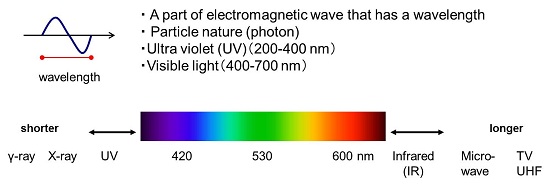Natural Products ChemistryGraduate School of Agricultural Science, Kobe University |

What is light?
Almost all the energy necessary for life on planet Earth comes from the sun. Electromagnetic waves deriver the energy. Light is a part of the electromagnetic wave and has particle nature (it is also called as photon.) The figure shows one wave and wavelength is the length of one wave. The waves have names such as UV, visible light, and so on, depending on the wavelengths. Representative names are listed in the figure. Bioluminescent systems emit visible light.

Light has energy (E), which is expressed with a formula (E=hυ). h is plank coefficient, and υ is vibrational number (light speed / the wavelength). Shorter wavelength has larger energy, because the light speed never change. Shorter wavelength makes vibrational number larger. As the result, the large vibrational number (υ) has large energy (E).
Many marine bioluminescent lives emit blue light. Blue light can travel longer distance in the ocean than red light.